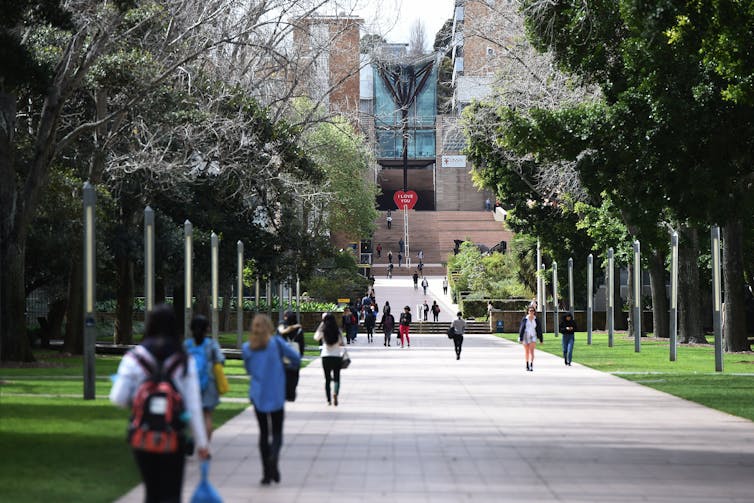Back in February, the Universities Accord final report recommended major changes to university funding.
It proposed a new body, the Australian Tertiary Education Commission, to oversee funding and link it to national goals. These include more people from disadvantaged backgrounds going to university, more Australians getting a tertiary qualification, and better matching enrolments with skills needs.
After accepting these recommendations in the budget, on Friday Education Minister Jason Clare released two consultation papers on how to implement them. One is on the new commission and the other looks at how student places would be distributed across universities.
There are big changes on the table and they would put a limit on domestic student places. This would mean all student places, both international and local, would be capped in Australia.
What does this mean for universities and students?
What happens under the current system?
Under the current funding system, universities have no fixed allocation of, or targets for, student places subsidised by the federal government. These are called “Commonwealth supported places” and sometimes called HECS places.
Except for medical courses and Indigenous students, funding is allocated in dollars rather than places. Each public university has a maximum public funding grant through an agreement with the federal government.
How many student places this grant supports depends on which courses students do. This is because the public subsidy per student (called a Commonwealth contribution), varies between courses. Universities choose how to allocate student places between disciplines, except in medicine.
For example, under the current contribution system, universities get a subsidy of only A$1,236 a year for each Commonwealth supported place in business, law and most arts disciplines. So, one million dollars from a university’s grant supports more than 800 student places in these disciplines. Most of the university’s funding comes from the student contribution, which is $16,323. By comparison, in engineering, the Commonwealth contribution is $18,292. One million dollars supports just 55 engineering places.
The current system creates tradeoffs. Moving student places to engineering to meet skills needs, while staying within the university’s maximum grant, could mean sacrificing hundreds of student places in business, law and arts.

What is the new system?
The proposed new funding system would be based on numbers of student places, not fixed dollar amounts. The government would decide on the total number of student places across Australia. The Australian Tertiary Education Commission would then divide that total up between universities.
Funding based on student places rather than dollar amounts improves on the current system. It makes the number of students easier to predict.
The government can see more clearly whether the number of student places aligns with its targets to have more Australians complete a tertiary qualification. Also, universities would not need to reduce total enrolments to increase the number of student places in disciplines, like engineering, with high Commonwealth contributions.
The change from a ‘soft’ to a ‘hard’ cap
But the changes will also remove flexibility in another way.
The current funding system puts a “soft cap” on student places at each university. A university cannot be paid more Commonwealth contributions revenue than it has been officially allocated. But it can take extra enrolments based solely on a student contribution (also known as HECS-only basis), a practice known as “over-enrolment”.
This would end under the new model. Universities would be given something called a “managed growth target”. This is a hard cap. If a university’s enrolments exceeded their target it would receive no funding at all for the above-target students.
If over-enrolments occur, students would still be charged a student contribution. But the money would go the government rather than the university.

‘Managed demand driven funding’ for equity students
The problems of these inflexible enrolment caps are highlighted by what the consultation paper confusingly calls “managed demand driven funding” for equity students.
For Indigenous bachelor degree students, genuine “demand driven funding” will continue. This means there will be no cap on their places and they will not count towards a university’s overall enrolment cap.
But other equity groups, which have not yet been specified (but presumably would be those from low socioeconomic backgrounds, regional areas and those with disability) will count towards each university’s cap.
As explained by the paper, two things will happen if an university applicant from one of these groups receives no offers.
First, the equity applicant will be offered a place in another university in their area, if that university has not already hit its enrolment cap.
If all local universities have hit their caps, a second process starts, of going back to the Australian Tertiary Education Commission for more places. This may or may not be successful.
This convoluted process could often be avoided if universities had the flexibility to take students above their cap on a student contribution basis only. The equity applicant could attend their preferred university, rather than one chosen for them, with no waiting for extra approval.
The process seems particularly inadequate when one of the government’s main policy aims with universities is to see more students from equity backgrounds go to university and get a degree.
What should happen now
If the government funds enough student places to meet national demand, and the Australian Tertiary Education Commission allocates these places to fit with where students want to study, the mismatch between supply and demand could be minimised.
But the commission can never completely foresee the preferences of the hundreds of thousands of people who apply for university each year.
Every year some universities will get more applicants than anticipated and others fewer. Student contribution-only places are a flexible way of quickly adjusting supply to demand. They should remain a feature of Australia’s higher education funding system.
Comments on the two consultation papers are due by July 26.

